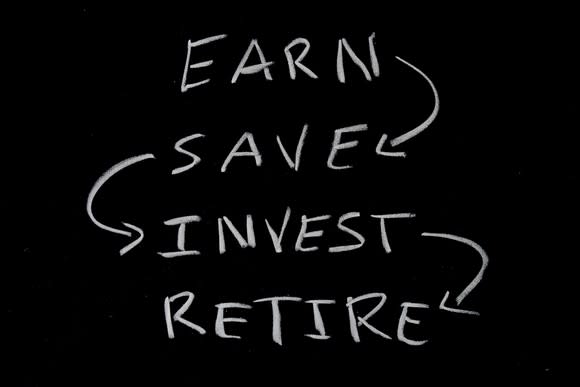5 Things You Can Do Right Now to Make Retirement Easier
A whopping 46% of Americans say they will not have enough money in retirement, according to a recent Gallup survey. Meanwhile, nearly one in five Americans older than 65 are still working -- because they can't afford to retire.
The burden of saving enough money to live on in retirement is largely on us these days, so it's smart to start preparing for retirement as soon as we can. Here are five things you can do right now to make your retirement easier and more pleasant.

Image source: Getty Images.
1. Make a plan!
First things first: You need a plan for how much income you'll need in retirement and how you'll get it.
You could start by estimating how much income you'll need each year in retirement -- and be conservative about it in case you encounter unexpected expenses or your estimates turn out to have been too rosy. Tally up your various income sources, such as Social Security or any pension income, and then see how much income you'll need to generate on your own. For example, the average annual Social Security benefit was recently about $17,000 ($1,413 per month), and you can get an estimate of how much you can expect from Social Security by creating a "my Social Security" account. If you think you'll need a total of $50,000 per year to get by in retirement, and you expect to get $20,000, from Social Security, then you'll need to figure out where the other $30,000 will come from.
To get an idea of how big a nest egg you'll need to generate the income you need, you can use the imperfect but still helpful 4% rule, which dictates that you withdraw 4% of your nest egg in your first year of retirement and then adjust that amount for inflation in subsequent years. To be more conservative, you might plan to start by withdrawing 3.5%. If you flip the rule around, you calculate the nest egg you'll need to generate the income you'll need: Multiply your needed annual income by 25 to get the your savings target, assuming a 4% withdrawal rate, or multiply by 28.5 if you're using a 3.5% initial withdrawal. For example, if you need to generate $30,000 in income, then you'd need to save up $750,000 assuming the 4% withdrawal rate and $855,000 if you're starting with a 3.5% withdrawal.
You might use this simple online calculator to help with your planning. You can plug your expected investment growth rate into the "interest rate" field and then try out different savings levels. For example, if you start with $0, sock away $10,000 per year, and expect it to grow by 8% annually, on average, over 25 years, you'll end up with almost $800,000. Try different scenarios that are realistic for you. Here are a few examples of how you might accumulate the sum that you need:
Growing at 8% for | Balance if Investing $5,000 annually | Balance if Investing $10,000 annually | Balance if Investing $15,000 annually |
|---|---|---|---|
10 years | $78,227 | $156,455 | $234,682 |
15 years | $146,621 | $293,243 | $439,864 |
20 years | $247,115 | $494,229 | $741,344 |
25 years | $394,772 | $789,544 | $1.2 million |
30 years | $611,729 | $1.2 million | $1.8 million |
Source: Calculations by author.
2. Consult a financial advisor
All those considerations above can be daunting, and rightfully so, as this is such important stuff. If you're feeling out of your comfort zone, you might want to tap the expertise of a financial professional. (Yes, financial pros will charge you, but they may end up saving and earning you much more than you pay them.) Don't just go with anyone, though. Ask around for strong references and perhaps choose a fee-only planner instead of a pro who may have conflicts of interest, such as commissions earned by selling you certain products. You can find some local fee-only pros at Napfa.org.

Image source: Getty Images.
3. Make the most of retirement accounts
To maximize your retirement savings, save as much income as possible and invest as aggressively as you can without losing sleep. Also make the most of tax-advantaged retirement accounts such as IRAs and 401(k)s. Each of those comes in two varieties: traditional or Roth. With a traditional IRA or 401(k), you contribute pre-tax money, reducing your taxable income (and thus your tax burden) in the year you make the contribution. For example, if you have taxable income of $75,000 and contribute $5,000, then your taxable income will drop to $70,000 for the year. The money grows in your account, and when you withdraw it in retirement, it's taxed at your ordinary income tax rate at the time -- which is often lower than your current rate.
With a Roth IRA or 401(k), you contribute post-tax money that doesn't reduce your taxable income at all in the contribution year. (Taxable income of $75,000 and a $5,000 contribution? Your taxable income remains $75,000 for the year.) Here's the big advantage of a Roth IRA or 401(k) is a big deal, though: Your money can grow in the account, and when you withdraw it in retirement, it's not taxed at all.
For 2018, the IRA contribution limit is $5,500 -- plus $1,000 for those aged 50 or older. 401(k) accounts enjoy far bigger 2018 contribution limits of $18,500, plus an additional $6,000 for those 50 and up. You can open IRA accounts at most major brokerages and many other financial services companies. If you can afford to save more than those limits, then you can open a regular, taxable account through a good brokerage. Just be sure to maximize your tax-advantaged savings before turning to a taxable account.
4. Keep your health in mind
One of the most critical considerations in your retirement planning should be your health. A 65-year-old couple retiring today will spend, on average, a total of $280,000 out of pocket on healthcare, per Fidelity Investments. (That's an average, of course -- meaning you might spend less or more.) Be sure you're saving enough to cover healthcare. Making smart Medicare-related moves can help, too.
Meanwhile, aim to stay as healthy as possible -- starting now. The healthier you are in retirement, the less money you'll likely spend on healthcare, and the more you'll enjoy your golden days. Plan to stay active and social in retirement. Being active can keep your bones and heart strong, while being social can keep you mentally and physically healthier and may even keep dementia at bay.
In retirement, many people find themselves bored, restless, or lonely. The routine of working is more important to some of us than we realize. Brace yourself for that and consider how you might deal with it -- maybe by getting a part-time job or taking up new hobbies. Be prepared to make some adjustments.
5. Make smart Social Security decisions
Finally, know that you have a fair amount of control over how much money you collect from Social Security. Namely, you can claim Social Security retirement benefits any time between age 62 and age 70, and the longer you wait, the bigger your monthly checks will be. The bonus you receive for waiting (or the reduction you get for filing early) depends partly on your full retirement age, which is 66 or 67 for most pre-retirees today. Read up on strategies to maximize your Social Security, especially by coordinating your actions with those of your spouse if you're married. For example, one good strategy for many married people is to start collecting the benefits of the spouse with the lower lifetime earnings record on time or early, while delaying the benefits of the higher-earning spouse. That way, the couple starts collecting some extra income early on, and when the higher earner hits 70, they can collect extra-large checks. Also, should that higher-earning spouse die first, the spouse with the smaller earnings history can collect those bigger benefit checks.
If you take some time to develop a sound retirement plan and you execute it well, you can end up with a far more comfortable and secure retirement.
More From The Motley Fool
The Motley Fool has a disclosure policy.

 Yahoo Finance
Yahoo Finance